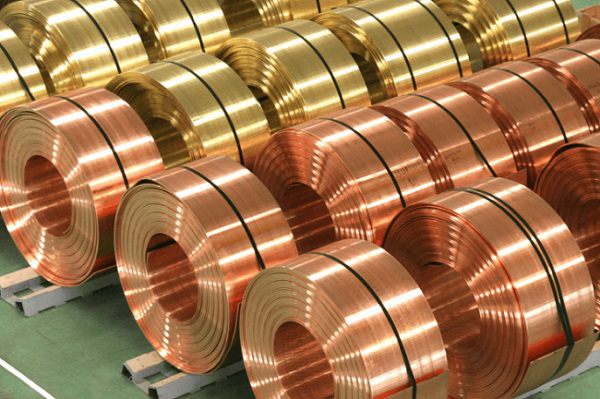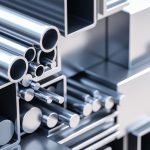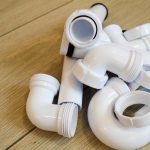Copper is the oldest metal used by man. It’s use dates back to prehistoric times. Copper has been mined for more than 10,000 years with a Copper pendant found in current day Iraq being dated to 8700BC. By 5000BC Copper was being smelted from simple Copper Oxides.
Copper is found as native metal and in minerals cuprite, malachite, azurite, chalcopyrite and bornite. It is also often a by-product of silver production. Sulphides, oxides and carbonates are the most important ores.
Copper and Copper alloys are some of the most versatile engineering materials available. The combination of physical properties such as strength, conductivity, corrosion resistance, machinability and ductility make Copper suitable for a wide range of applications. These properties can be further enhanced with variations in composition and manufacturing methods.
The largest end use for Copper is in the building industry. Within the building industry the use of copper based materials is broad. Construction industry related applications for Copper include:
~ Roofing
~ Cladding
~ Rainwater systems
~ Heating systems
~ Water pipes and fittings
~ Oil and gas lines
~ Electrical wiring
Copper Usage
The building industry is the largest single consumer of Copper alloys. The following list is a breakdown of Copper consumption by industry on an annual basis:
~ Building industry – 47%
~ Electronic products – 23%
~ Transportation – 10%
~ Consumer products – 11%
~ Industrial machinery – 9%
There are around 370 commercial compositions for Copper alloys. The most common alloy tends to be C106/ CW024A – the standard water tube grade of Copper.
World consumption of Copper and Copper alloys now exceeds 18 million tonnes per annum.
Applications
Copper and Copper alloys can be used in an extraordinary range of applications. Some of the applications fro Copper include:
~ Power transmission lines
~ Architectural applications
~ Cooking utensils
~ Spark plugs
~ Electrical wiring, cables and busbars
~ High conductivity wires
~ Electrodes
~ Heat exchangers
~ Refrigeration tubing
~ Plumbing
~ Water-cooled Copper crucibles
In addition, there are many more applications for the Copper Alloys – Brass and Bronze
Structure
Copper has a face centred cubic (FCC) crystal structure. Copper and its alloys have a range of yellow/gold/red colours and when polished develop a bright metallic lustre.
Recycling
Copper alloys are highly suited to recycling. Around 40% of the annual consumption of Copper alloys is derived from recycled Copper materials.
The recycling rate for Free Machining Brass (CZ121/CW614N) is particularly high with clean/dry swarf having a high value, which contributes to the cost-benefit calculations in material selection.
Properties of Copper Alloys
Key Properties of Copper Alloys
Copper is a tough, ductile and malleable material. These properties make copper extremely suitable for tube forming, wire drawing, spinning and deep drawing. The other key properties exhibited by Copper and its alloys include:
~ Excellent heat conductivity
~ Excellent electrical conductivity
~ Good corrosion resistance
~ Good biofouling resistance
~ Good machinability
~ Retention of mechanical and electrical properties at cryogenic temperatures
~ Non-magnetic
Other Properties
~ Copper and Copper alloys have a peculiar smell and disagreeable taste. These may be transferred by contact and therefore should be kept clear of foodstuffs, although some cooking pans do use these metals.
~ Most commercially used metals have a metallic white or silver colour. Copper and Copper alloys have a range of yellow/gold/red colours.
Melting Point
The melting point for pure Copper is 1083ºC.
Corrosion Resistance
All Copper alloys resist corrosion by fresh water and steam. In most rural, marine and industrial atmospheres Copper alloys are also resistant to corrosion. Copper is resistant to saline solutions, soils, non-oxidising minerals, organic acids and caustic solutions. Moist ammonia, halogens, sulphides, solutions containing ammonia ions and oxidising acids, like nitric acid, will attack Copper. Copper alloys also have poor resistance to inorganic acids.
The corrosion resistance of Copper alloys comes from the formation of adherent films on the material surface. These films are relatively impervious to corrosion therefore protecting the base metal from further attack.
Copper Nickel alloys, Aluminium Brass, and Aluminium Bronzes demonstrate superior resistance to saltwater corrosion.
Electrical Conductivity
The electrical conductivity of copper is second only to silver. The conductivity of Copper is 97% of the conductivity of Silver. Due to its much lower cost and greater abundance, Copper has traditionally been the standard material used for electricity transmission applications.
However, weight considerations mean that a large proportion of overhead high voltage power lines now use Aluminium rather than Copper. By weight, the conductivity of Aluminium is around twice that of Copper. The Aluminium alloys used do have a low strength and need to be reinforced with a galvanised or Aluminium coated high tensile steel wire in each strand.
Although additions of other elements will improve properties like strength, there will be some loss in electrical conductivity. As an example a 1% addition of Cadmium can increase strength by 50%. However, this will result in a corresponding decrease in electrical conductivity of 15%.
Surface Oxidation / Patination
Most Copper alloys will develop a blue-green patina when exposed to the elements outdoors. Typical of this is the colour of the Copper Statue of Liberty in New York. Some Copper alloys will darken after prolonged exposure to the elements and take on a brown to black colour.
Lacquer coatings can be used to protect the surface and retain the original alloy colour. An acrylic coating with benzotriazole as an additive will last several years under most outdoor, abrasion-free conditions.
Yield Strength
The yield point for Copper alloys is not sharply defined. As a result it tends to be reported as either a 0.5% extension under load or as 0.2% offset.
Most commonly the 0.5% extension yield strength of annealed material registers as approximately one-third the tensile strength. Hardening by cold working means the material becomes less ductile, and yield strength approaches the tensile strength.
Joining
Commonly employed processes such as brazing, welding and soldering can be used to join most Copper alloys. Soldering is often used for electrical connections. High Lead content alloys are unsuitable for welding.
Copper and Copper alloys can also be joined using mechanical means such as rivets and screws.
Hot & Cold Working
Although able to be work hardened, Copper and Copper alloys can be both hot and cold worked.
Ductility can be restored by annealing. This can be done either by a specific annealing process or by incidental annealing through welding or brazing procedures.
Temper
Copper alloys can be specified according to temper levels. The temper is imparted by cold working and subsequent degrees of annealing.
Typical tempers for Copper alloys are
~ Soft
~ Half-hard
~ Hard
~ Spring
~ Extra-spring.
Yield strength of a hard-temper Copper alloy is approximately two-thirds of the materials’ tensile strength.


